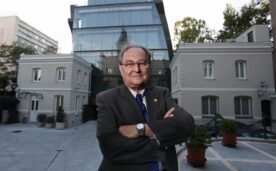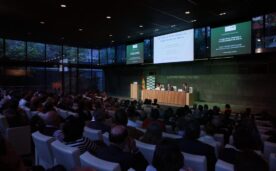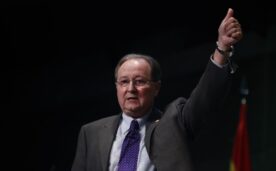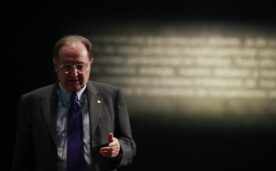On 16 October 2012, the Rafael del Pino Foundation organised the Keynote Conference "Life in the Universe and the Exploration of Mars". delivered by Juan Pérez-Mercader.
Juan Pérez-Mercader is a member of the Harvard Origins of Life Initiative, a project involving Biology, Chemistry, Physics, Computer Science and Engineering, which investigates theoretically and experimentally the design and chemical synthesis of bio-inspired artificial systems that mimic the properties of natural living systems: a new form of "synthetic biology".
He is a member of the editorial board of the scientific journals "Astrobiology" and "International Journal of Astrobiology" and of the "Revista de Occidente". He is an Academician of the International Academy of Astronautics and an Academician of the European Academy of Sciences and Arts. He has participated in the review of the reports on Planetary Exploration Strategies prepared for NASA by the US National Academy of Sciences.
Pérez-Mercader holds a degree in Physics from the University of Seville, a Master of Science in Mathematics and Theoretical Physics from Trinity College Dublin, as well as a Master of Philosophy from the City University of New York and a Doctor of Philosophy in Theoretical Physics from the City College of New York validated by the Complutense University.
From November 1999 to March 2008 he was Director of the Centro de Astrobiología (CAB), a joint INTA-CSIC centre that he set up in Spain in association with the NASA Astrobiology Institute and of which he is the founder and main driving force. The CAB, a pioneering institution in the world, is dedicated to understanding the origin of life in the Universe, including the Earth. Today it has more than 150 scientists and engineers of various nationalities. Among other projects promoted and developed under its direction, the CAB has undertaken the exploration of the Rio Tinto as a potential analogue of the past Mars and participates through an instrument in NASA's Mars Science Laboratory (MSL) mission.
He is a Research Professor on leave of absence from the Consejo Superior de Investigaciones Científicas and has been a Consultant for the Los Alamos National Laboratory (New Mexico) from 1989 to 2008. Since 2008 he has been External Faculty at the Santa Fe Institute, Santa Fe, New Mexico. In early 2010 he moved to Harvard University, where he is a Senior Research Fellow in the Department of Earth and Planetary Sciences.
As a science professional he is interested in all scientific and technological aspects of problems at the frontier shared by physics, biology, planetary sciences, computation and engineering.
He has predicted the decay of the proton; he has explained the fractal distribution of galaxies and the hierarchical structure of the Universe, extending the physics of critical phenomena to the Universe. He is co-discoverer of Gravito-Magnetism, a property of space-time predicted by Einstein and others in 1918 and which he has detected and measured in 1998. He has also worked on the evolution of RNA viruses, on the properties of information in living things and on their physical description. He has more than a hundred original papers published in the most prestigious international scientific journals: PLoS ONE, Science, Physical Review Letters, Proceedings of the National Academy of Sciences of the USA, Nuclear Physics B, et c. He also holds two patents in biotechnology.
From 1999 to 2008 he has been (with the continuous and in many cases intense support of institutions and individuals in Spain and the USA) the architect and main driving force behind the current Spanish participation in the exploration of Mars. This activity has culminated in the "Made in Spain" contribution of infrastructure (the HGA direct communication antenna) and instrumentation (the REMS weather station) on board MSL. Both have been operating on the surface of Mars since August this year.
He has received numerous prizes and awards. Among them is one of the annual awards of the Gravity Research Foundation of Massachusetts in 1996; the Joint Chair of the European Physical Society and the Swiss Academy of Sciences to deliver the Inaugural Lecture at the 2005 Centennial Celebration in Bern of Einstein's work done there in 1905. In 2003 NASA awarded him its Public Service Medal, the highest award NASA confers on a non-employee. In 2008 he was awarded the Plaque of Honour of the Spanish Association of Scientists. There are several schools, an institute and an astronomical association named after him.
His concern for the environment is well known (he has served Andalusia as President of the Governing Board of the Doñana Natural Park from November 1998 to January 2007 and received the Andalusia Environment Award in 2008). A lover of popular science, he has collaborated for eight years in Radio Nacional de España (Radio 1) with two weekly programmes dedicated to Science. He is also a trustee of the "José Ortega y Gasset-Gregorio Marañón" Foundation and the "Rio Tinto" Foundation.







